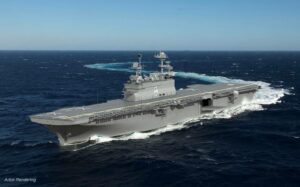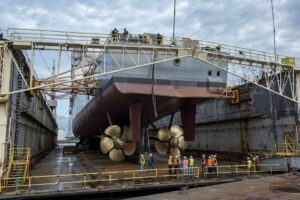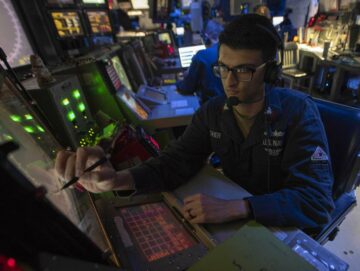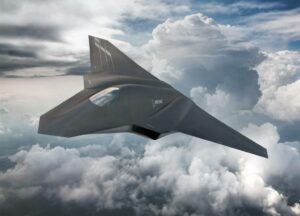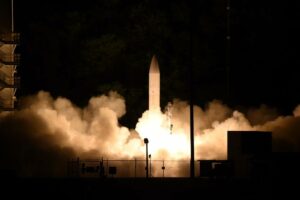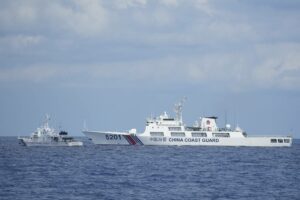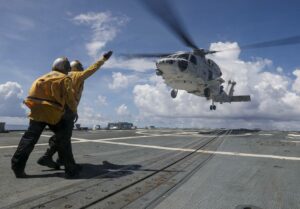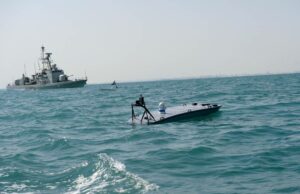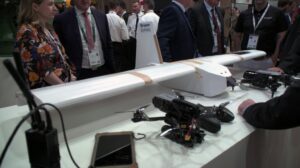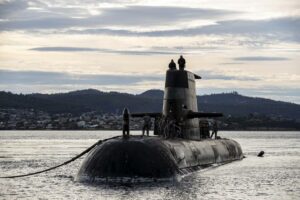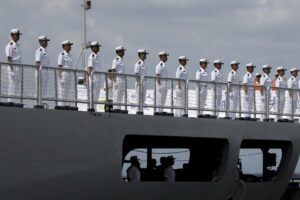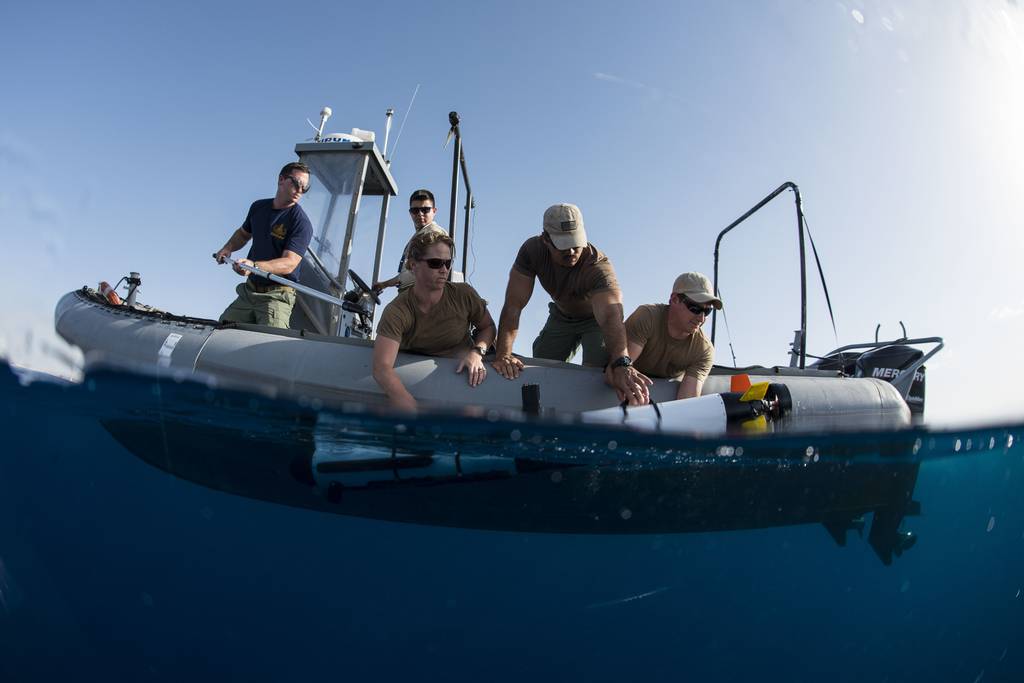
ABU DHABI, United Arab Emirates — Deploying fully autonomous underwater systems is the key to maintaining an upper hand in the domain, according to a former French Navy commander.
“We consider that the underwater sector is the last area of freedom for naval operations,” Aymeric Moullart de Torcy, who now handles unmanned systems marketing at Naval Group, told Defense News this week.
“At Naval Group, we believe that to take advantage of the whole potential of the underwater world, you have to go fully autonomous [independent of data link], which is a step that the Ukrainians do not appear to have taken yet,” he said at the UMEX trade show, taking place Jan. 22-25 in the United Arab Emirates.
Ukraine has used cheap, readily available drones as formidable weapons, despite Russia’s more modern Air Force. Russia launched a full-scale invasion of Ukraine in February 2022, which has heavily featured aerial weaponry and artillery systems.
“At the same time, only the richest will survive in the underwater world — richest in terms of those who sufficiently invest in developing the appropriate capabilities and those with experience in this domain,” de Torcy said.
Several factors come into play when creating unmanned platforms for use in the water. These can include taking off from the water, which can be an obstacle in itself, as well as retrieving an unmanned underwater vehicle after mission completion, a task sometimes difficult due to the amount of water displaced.
The company representative noted that another challenging factor for operators may relate to the level of maturity of the technology deployed.
“For instance, in looking at Ukraine, they have developed very clever UUVs but many still require permanent data link, which underwater can be very limiting, as it means you have an antenna above water and are more detectable and cannot dive,” de Tourcy said.
Over the summer, the French company won a contract by the nation’s defense procurement agency DGA to study the design of an unmanned combat underwater vehicle. The first phase began this month and consists of use cases of the technology that will end with the definition of a prototype.
Once completed, the second phase will involve further trialing of the prototype with the French Navy as well as other naval forces. Naval Group said it will produce a prototype within the next three years — by the end of 2026 or early 2027.
The system is meant to carry out intelligence-gathering missions above and below the surface as well as operate in contested environments.
De Tourcy warned that using cheap assets in these demanding environments may not allow one to have a complete aperture of the threat or meet all mission set requirements.
“If you want to have low-cost products, you will have limited products,” he said.
The advancement of unmanned underwater technology does not symbolize that crewed assets are becoming irrelevant in naval operations, de Tourcy stressed, but rather it shows the importance of manned-unmanned teaming.
“For high-end operations, you need to have both manned and unmanned assets complement each other, and currently the manned platforms are the ones with the most experience,” he said.
Elisabeth Gosselin-Malo is a Europe correspondent for Defense News. She covers a wide range of topics related to military procurement and international security, and specializes in reporting on the aviation sector. She is based in Milan, Italy.
- SEO Powered Content & PR Distribution. Get Amplified Today.
- PlatoData.Network Vertical Generative Ai. Empower Yourself. Access Here.
- PlatoAiStream. Web3 Intelligence. Knowledge Amplified. Access Here.
- PlatoESG. Carbon, CleanTech, Energy, Environment, Solar, Waste Management. Access Here.
- PlatoHealth. Biotech and Clinical Trials Intelligence. Access Here.
- Source: https://www.defensenews.com/naval/2024/01/25/naval-group-pitches-autonomous-systems-as-key-to-underwater-operations/
- :has
- :is
- :not
- 10
- 2022
- 2026
- 70
- a
- above
- According
- advancement
- ADvantage
- After
- agency
- AIR
- Air Force
- All
- allow
- amount
- an
- and
- Another
- antenna
- appear
- appropriate
- Arab
- Arab Emirates
- ARE
- AREA
- AS
- Assets
- At
- autonomous
- autonomous systems
- available
- aviation
- based
- BE
- becoming
- began
- believe
- below
- both
- but
- by
- CAN
- cannot
- capabilities
- carry
- cases
- challenging
- cheap
- combat
- come
- company
- Complement
- complete
- Completed
- completion
- Consider
- consists
- contract
- covers
- Creating
- Currently
- data
- de
- Defense
- definition
- demanding
- deployed
- deploying
- Design
- Despite
- developed
- developing
- Dhabi
- difficult
- displaced
- dive
- do
- does
- domain
- Drones
- due
- each
- Early
- emirates
- end
- environments
- Europe
- experience
- factor
- factors
- featured
- February
- First
- For
- Force
- Forces
- Former
- formidable
- Freedom
- French
- from
- fully
- further
- Go
- Group
- hand
- Handles
- Have
- he
- heavily
- High-End
- HTTPS
- images
- importance
- in
- include
- independent
- instance
- International
- into
- Invest
- involve
- IT
- Italy
- itself
- Jan
- jpg
- Key
- Last
- launched
- Level
- Limited
- LINK
- looking
- low-cost
- maintaining
- many
- Marketing
- maturity
- May..
- means
- meant
- Meet
- MILAN
- Military
- Mission
- missions
- Modern
- Month
- more
- most
- Nations
- Need
- news
- next
- noted
- now
- obstacle
- of
- off
- on
- ONE
- ones
- only
- operate
- Operations
- operators
- or
- Other
- out
- permanent
- phase
- pitches
- Place
- Platforms
- plato
- Plato Data Intelligence
- PlatoData
- Play
- potential
- procurement
- produce
- Products
- prototype
- range
- rather
- readily
- related
- Reporting
- representative
- require
- Requirements
- Russia
- Said
- same
- Second
- sector
- security
- set
- she
- show
- Shows
- sometimes
- specializes
- Step
- Still
- Study
- summer
- Surface
- survive
- system
- Systems
- Take
- taken
- taking
- Task
- Technology
- terms
- that
- The
- These
- they
- this
- this week
- those
- threat
- three
- time
- to
- told
- Topics
- trade
- Ukraine
- Ukrainians
- underwater
- United
- United Arab Emirates
- use
- used
- using
- vehicle
- very
- want
- warned
- Water
- we
- Weapons
- week
- WELL
- when
- which
- WHO
- whole
- wide
- Wide range
- will
- with
- within
- Won
- world
- years
- yet
- you
- zephyrnet

